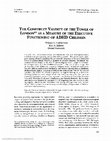Papers by Dr. William Culbertson
Archives of Clinical Neuropsychology, 1997
Archives of Clinical Neuropsychology, 1997
Archives of Clinical Neuropsychology, 2000
refer to performance in an impaired direction). The low base rates of impaired performance on neu... more refer to performance in an impaired direction). The low base rates of impaired performance on neuropsychological measures in young healthy adults observed in this study provide a concrete basis on which to more accurately and confidently assess and diagnose neuropsychological impairment similarly aged individuals with known or suspected neurological disease. Assessing executive function in the MR population: an investigation of the TOL-Dx and MWCST Kennedy CH, Zillmer EA, Culbertson WC.

Dementia and Geriatric Cognitive Disorders, 2005
Background: Executive impairment is common in Parkinson’s disease (PD). However, it is unknown wh... more Background: Executive impairment is common in Parkinson’s disease (PD). However, it is unknown which dimensions of executive function are assessed by commonly used neuropsychological instruments and if clinical correlates of specific dimensions exist. Method: A convenience sample of 46 PD patients was evaluated with three executive function tests: the Tower of London-Drexel, the Trail-Making Test and the Stroop Color-Word Test. Factor analysis was used to probe for dimensions of executive control, and linear regression models were used to explore the association between the generated factors and other clinical features. Results: Factor analysis revealed two executive factors, one related to planning (eigenvalue = 4.2) and the other to inhibitory control (eigenvalue = 1.8), together accounting for 75% of the variance in scores. In linear regression models, poorer planning was associated with increasing severity of apathy (t = 2.11, p = 0.041), and diminished inhibitory control was associated with increasing severity of parkinsonism (t = 2.78, p = 0.008) and lower educational level (t = –2.23, p = 0.032). Conclusions: Planning deficits and diminished inhibitory control are two dimensions of executive impairment in PD, the former associated with decreased motivation and the latter with increased motor slowing. Similar performance on both executive and non-executive components of these instruments suggests that results of executive testing in PD may be confounded by non-executive deficits.
Journal of Experimental Education, Jun 1, 1982
Journal of Clinical Psychology, 1977
The Elizur Test of Psycho-Organicity and the Hooper Visual Organization Test were studied as meas... more The Elizur Test of Psycho-Organicity and the Hooper Visual Organization Test were studied as measures of neurological impairment with a sample of 40 neurologically impaired and normal children. The ETPO identified a significant number of neurologically impaired children, while the HVOT was of limited value both singularly and in combination with the ETPO.
The Journal of Experimental Education, 1982
Psychology in the Schools, 1982
Forty-nine learning disabled (LD), 30 emotionally disturbed(ED), and 44 unclassified (UC) boys or... more Forty-nine learning disabled (LD), 30 emotionally disturbed(ED), and 44 unclassified (UC) boys originally sampled by Brooks (Note 1) and Jackson (Note 4) when they were 6 to 11 years of age, were relocated in 1979, and their current classification determined. Lambda, an index of predictive association, showed that a 53% improvement in the accuracy of prediction of 1979 classification was obtained when 1975 classification was given. The ED classification was the least stable, with 60% of the children originally classified ED changing their classification over four years, though only 19% of the originally LD and ED children were unclassified four years later.
Archives of Clinical Neuropsychology, 1997
person compared to time and place. Moreover, knowledge about the year and season was more intact ... more person compared to time and place. Moreover, knowledge about the year and season was more intact than orientation to day and date. Deteriorating memory functioning was positively correlated with increased disorientation by the fourth testing occasion, supporting the association between memory and orientation.

Archives of Clinical Neuropsychology, 1998
In the current study, the Tower of London (Shallice, 1982) was modified to enhance its clinical u... more In the current study, the Tower of London (Shallice, 1982) was modified to enhance its clinical utility as a measure of childhood executive functioning. The Tower of London-Drexel (TOL DX) was administered to normal control (NC; N ϭ 56) and attention-deficit hyperactivity disorder (ADHD; N ϭ 99) children (ages 7 to 12) to determine whether age-related changes in performance were evident, to gather normative data, and to evaluate the test-retest reliability and criterion-validity of the measure. The results revealed age-related changes in score performance, age-group normative data, an acceptable level of reliability and significant differences in performance of NC and ADHD subjects. Further, discriminant analysis classification rates determined that the TOL DX was sensitive and highly specific to ADHD. Implications and limitations of the study are discussed.

Cognitive and behavioral neurology : official journal of the Society for Behavioral and Cognitive Neurology, 2004
The purpose of the study was to determine whether patients with Parkinson disease (PD) demonstrat... more The purpose of the study was to determine whether patients with Parkinson disease (PD) demonstrate different memory profiles. Specifically, we sought to ascertain whether the memory performance of PD patients can be categorized as fitting an unimpaired, an impaired retrieval, or an impaired encoding memory profile. Cognitive impairment in PD is usually described as subcortical-frontal in nature. However, neuropathophysiological changes consistent with diffuse cortical disease are also reported. Establishing memory subtypes in PD could potentially assist in reducing the observed heterogeneity of disease presentation, establishing prognosis, making clinical decisions, and defining endpoints in clinical trials. : A sample of 63 PD patients was evaluated with the Hopkins Verbal Learning Test-Revised (HVLT-R). Cluster analysis was used to classify patients into three memory subgroups based on performance on free recall, intrusion errors, and recall enhancement with recognition. Subgroup ...

Dementia and Geriatric Cognitive Disorders, 2005
Background: Executive impairment is common in Parkinson’s disease (PD). However, it is unknown wh... more Background: Executive impairment is common in Parkinson’s disease (PD). However, it is unknown which dimensions of executive function are assessed by commonly used neuropsychological instruments and if clinical correlates of specific dimensions exist. Method: A convenience sample of 46 PD patients was evaluated with three executive function tests: the Tower of London-Drexel, the Trail-Making Test and the Stroop Color-Word Test. Factor analysis was used to probe for dimensions of executive control, and linear regression models were used to explore the association between the generated factors and other clinical features. Results: Factor analysis revealed two executive factors, one related to planning (eigenvalue = 4.2) and the other to inhibitory control (eigenvalue = 1.8), together accounting for 75% of the variance in scores. In linear regression models, poorer planning was associated with increasing severity of apathy (t = 2.11, p = 0.041), and diminished inhibitory control was as...

Assessment, 2004
The aim of the study was to investigate the utility of the Tower of London-Drexel (TOLDX ) in ass... more The aim of the study was to investigate the utility of the Tower of London-Drexel (TOLDX ) in assessing the executive deficits associated with Parkinson’s disease (PD). We sought to determine whether the TOLDX would differentiate between (a) patients with PD and healthy control participants (HCP), (b) demented and nondemented patients, and (c) depressed and nondepressed patients. A new TOLDX score, stimulus bound, was introduced to assess utilization behaviors. Furthermore, the convergent and divergent validity of the TOLDX was examined. The TOLDX total move, rule and time violation, and stimulus-bound scores of patients with PD significantly differed from the HCP. Demented and nondemented patients also differed significantly in their TODX performance, with the stimulus-bound score being the most significantly differentiating score. However, the depressed and nondepressed patients did not differ in their TOLDX performance. Support was found for the convergent and divergent validity ...

Assessment, 1998
Currently, there are a limited number of measures that have been developed to assess childhood ex... more Currently, there are a limited number of measures that have been developed to assess childhood executive planning and problem-solving abilities. The present study represents ongoing efforts to determine the psychometric properties of the newly developed Tower of London-Drexel (TOLDX), a measure of executive functions. Specifically, the construct-related validity of the TOLDX was investigated with a sample of attentiondeficit hyperactivity disorder (ADHD) children (N = 129), 7 to 15 years of age. The performance of the children on a neuropsychological battery of measures sensitive to executive abilities, psychometric intelligence, and memory was subjected to maximumlikelihood factor analysis. A four-factor solution was extracted that "best fit" the selected variables. The TOLDX was found to produce the highest loading on an Executive Planning/Inhibition factor comprised of other executive measures. The Executive Planning/Inhibition measure was separate from factors of Execu...

Archives of Clinical Neuropsychology, 1995
collapsed into one nonsimulating group. Using RMT scores, 87.5% of the nonsimulators and 75% of t... more collapsed into one nonsimulating group. Using RMT scores, 87.5% of the nonsimulators and 75% of the simulators were correctly classified. Ninty percent of the nonsimulators and 62.5% of the simulators were correctly classified with the RAVLT. Merits of forced choice measures and free recall measures in detecting feigned memory deficits are discussed. Cuibertson, W. C., & Zillmer, E. A. Tower of London Performance in Children and Adolescents: Relationships to Neuropsychological Measures of Frontal Lobe Functioning. Recent research attention has focused on issues of frontal lobe development and deficits in younger populations. However, relatively few neuropsychological techniques have evolved that assess emerging frontal lobe functioning in children and adolescents. The purpose of the present study was to examine the usefulness of the Tower of London Task as a measure of executive, higher-order problem-solving. Specifically, 70 school-aged children and adolescents (age range 7-15) with attention, activity, or impulse concerns were evaluated. The neuropsychological battery included the Tower of London Task, WCST, WISC-III, Trail Making Test A and B, Computerized Mazes, Delayed Response Test, Stroop Color and Word Test, Switching Attention Test, Continuous Performance Test, and Selective Reminding Test. Parent and teachers completed rating scales of behavioral problems and distress including the Child Behavioral Checklist for Ages 4-18, Teacher's Report Form and Conners' Rating Scales. Results indicated significant relationships between Tower of London performance (number of moves, time, and rule violations) and neuropsychological measures of planning (Computerized Mazes), concept formation and cognitive flexibility (WCST), impulsivity/response inhibition (Stroop Color and Word Test), response shifting (Switching Attention Test) and attention (Continuous Performance Test). The Tower of London performance was relatively independent of measures of psychometric intelligence (for example, WlSC-III Information, Similarities, Picture Completion and Coding), memory (Selective Reminding Test) and parent/teacher rating scales. Results suggest that the Tower of London Task has potential to be a meaningful measure of higher-order problem-solving (independent of intelligence) in younger populations and may be a purer measure of executive planning compared to other frontal lobe tests which appear more specific to functions of abstraction, mental flexibility, response regulation, and attention allocation. Due to its ease of administration, brevity, and game-like appeal, it is well-tolerated among younger subjects. Theoretical issues and practical implications regarding the neurological assessment of frontal lobe functioning in younger populations will be presented.

Uploads
Papers by Dr. William Culbertson